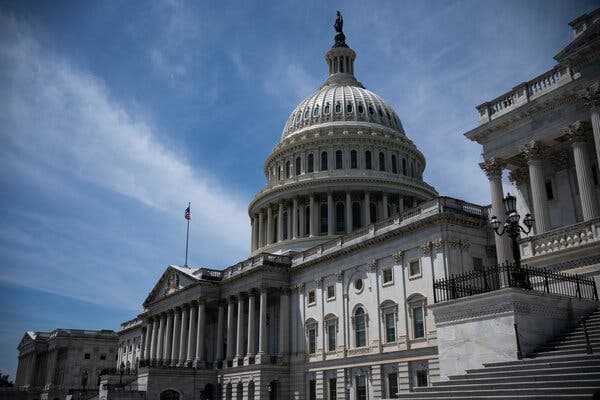Details are trickling out about the accord that could avert a default on the national debt. Here’s what to know.
-
Send any friend a story
As a subscriber, you have “>10 gift articles to give each month. Anyone can read what you share.
Give this article

The Capitol building, which was the site of many news conferences on the debt-ceiling talks this past week.
President Biden and Speaker Kevin McCarthy reached an agreement on Saturday to raise the debt ceiling while imposing new restraints on federal spending. If approved by Congress, it will end a partisan deadlock and avert a potentially devastating national default.
The deal will not only resolve the high-octane dispute over debt and spending issues that has gripped Washington for weeks but also enact important changes in environmental permitting, work requirements for social safety-net programs, and Internal Revenue Service tax enforcement.
The accord, described as an agreement in principle that was cemented during a telephone call between Mr. Biden at Camp David and Mr. McCarthy back in Washington, still needs to be translated into formal legislative language before it is deemed final. Details were only beginning to trickle out Saturday night, and many questions remained outstanding.
But here are some takeaways based on the information initially made available.
The debt ceiling would be increased until 2025, after the next election.
The federal government reached the $31.4 trillion debt ceiling set by law in January, but the Treasury Department has been using various accounting tricks to avoid breaching it. Treasury Secretary Janet L. Yellen said on Friday that her department would run out of those measures by June 5, at which point the government would not be able to meet its obligations.
The deal sealed by Mr. Biden and Mr. McCarthy would raise the debt ceiling for two years to take it beyond the 2024 election, so neither would have to address the issue again in the current term. Republicans had originally proposed one year. Both sides are banking on winning the 2024 election and being in a stronger political position when the ceiling is reached next time.
Domestic spending would be capped, but not as much as Republicans wanted.
Mr. McCarthy’s Republicans insisted that any increase in the debt ceiling be conditioned on spending cuts, so the agreement he reached with Mr. Biden would limit certain programs to last the same two years for which the debt ceiling would be raised. Republicans had originally sought a 10-year time frame for spending limits but agreed to the shorter horizon.
The deal holds nondefense spending in 2024 at roughly its 2023 level and increases it by 1 percent in 2025, in part by redirecting funding from other programs. Among other things, the agreement would cut about $10 billion out of the $80 billion that Mr. Biden previously secured to help the I.R.S. go after wealthy tax cheats, and would use that money to preserve domestic programs that otherwise would have been cut.
Some of the billions of dollars left over from the Covid-19 pandemic relief package passed shortly after Mr. Biden took office would be clawed back. A New York Times analysis suggests the limits will reduce federal spending overall by about $650 billion over a decade — a fraction of the cuts Republicans originally sought — if spending grows at the anticipated rate of inflation after the caps lift in two years.
Defense, Social Security, Medicare and veterans’ programs would be shielded.
The agreement would protect the military and entitlements like Social Security and Medicare from spending cuts imposed on other parts of government. It would also fully finance medical care for veterans, including expanded services for those exposed to toxic burn pits.
The deal would effectively preserve substantial increases won by the Biden administration over the last two years in areas like Title I education funding for low-income students, Child Care and Development Block Grants, cancer research and other priorities of the president. It would leave intact Mr. Biden’s efforts to forgive $400 billion in student loan debt in coming decades, although that faces a challenge in the Supreme Court. But it would include none of the tax increases on the wealthy and corporations that Mr. Biden sought in his original budget proposal.
Some recipients of government assistance would face new work requirements.
New work requirements would be imposed on some recipients of government aid, including food stamps and the Temporary Assistance for Needy Families program. Among other things, the agreement would limit how long people under 54 without children could receive food stamps, although those limits would expire in 2030 unless renewed by Congress. The package would also expand food stamp access for veterans and homeless people.
Major energy projects would be granted a streamlined review process.
Environmental permitting for major energy projects would be streamlined. A single lead agency would be charged with developing a single review document according to a public timeline. The agreement would enact these changes without curtailing the overall scope of the current review process, cutting down the statute of limitations, imposing barriers to standing or taking away injunctive relief or other judicial remedies.
Peter Baker is the chief White House correspondent and has covered the last five presidents for The Times and The Washington Post. He is the author of seven books, most recently “The Divider: Trump in the White House, 2017-2021,” with Susan Glasser. @peterbakernyt • Facebook
- Give this article
Source: nytimes.com



